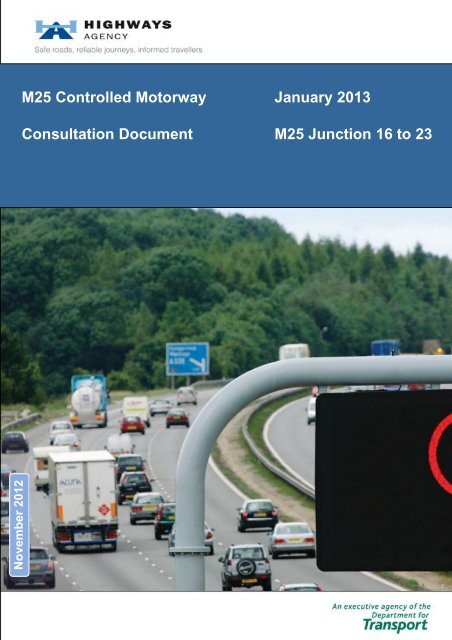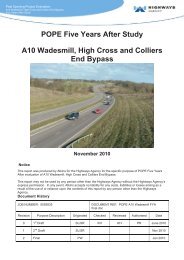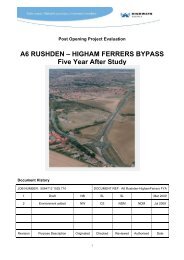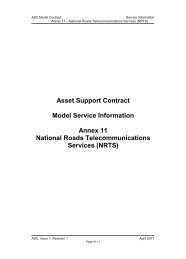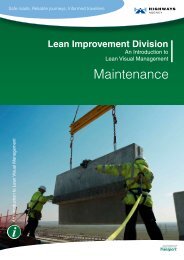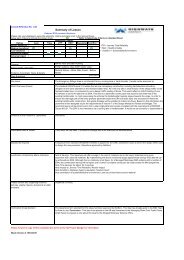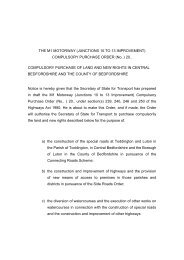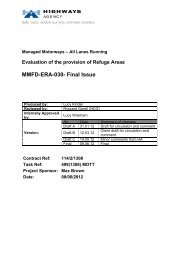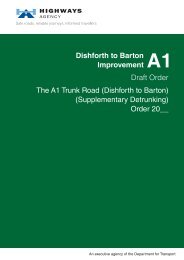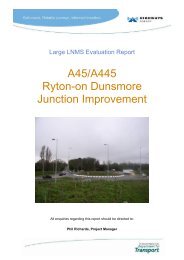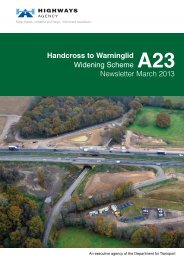M25 Managed Motorways J16 - Highways Agency
M25 Managed Motorways J16 - Highways Agency
M25 Managed Motorways J16 - Highways Agency
- No tags were found...
You also want an ePaper? Increase the reach of your titles
YUMPU automatically turns print PDFs into web optimized ePapers that Google loves.
<strong>M25</strong> Controlled Motorway January 2013Consultation Document <strong>M25</strong> Junction 16 to 23November 2012
How to Respond: Please send your consultation response using the“Consultation Response Form” at Appendix B to:John Martin<strong>Highways</strong> <strong>Agency</strong>Federated HouseLondon RoadDorkingSurreyRH4 1SZOr you can respond to the consultation by email:<strong>M25</strong>Widening@highways.gsi.gov.ukWhen responding, please state whether you are respondingas an individual or representing the views of anorganisation. If responding on behalf of a largerorganisation please make it clear who the organisationrepresents, and where applicable, how the views ofmembers were assembled.Additional waysto becomeinvolved:After theconsultation:The <strong>Highways</strong> <strong>Agency</strong> website will include a copy of thisconsultation pack which will be available to the generalpublic. The website address is:http://www.highways.gov.uk/consultationsAll responses received from consultees within theconsultation period will be considered and responded to asnecessary. Following the consultation, a summary reportwill be made available on the <strong>Highways</strong> <strong>Agency</strong> website.The summary report will provide an analysis of responsesreceived and the <strong>Highways</strong> <strong>Agency</strong>’s response.Subject to the results of the consultation, we envisage thatthe variable mandatory speed limits will be introducedAugust 2013.Compliance withthe ConsultationPrinciples:This consultation complies with the Government’sConsultation Principles.Backgroundiii
Getting to thisstage:In November 2002, the London Orbital Multi-Modal Study(ORBIT MMS) made recommendations for a long-termstrategy to address congestion and traffic growth on the <strong>M25</strong>.The study among other things recommended improvementworks to the <strong>M25</strong> including widening parts of the motorwaybetween Junctions 16 and 30, between Junction 1b and 3,and between Junctions 5 and 7.The Government has acted upon this recommendation andundertaken a £6 billion investment programme to improve andmake better use of motorways and other key roads. Whilstbeing widened, the works will also include the introduction ofvariable mandatory speed limits, which builds upon similarschemes already introduced on the <strong>M25</strong> and is a scheme totackle congestion through the introduction of new technology.iv
CONTENTSExecutive Summary................................................................................................................................vi1 HOW ARE WE CONDUCTING THE CONSULTATION ....................................................................11.1 What is this consultation about? ........................................................................................................11.2 Why do we need this new technology?..............................................................................................11.3 Joining the debate..............................................................................................................................11.4 Sending your consultation response ..................................................................................................11.5 How we will act on your responses ....................................................................................................21.6 Further information.............................................................................................................................21.7 Government’s consultation principles.................................................................................................32 GENERAL INFORMATION ON THE CONTROLLED MOTORWAYS SCHEME..............................42.1 Proposed Extent of the Controlled Motorway scheme .......................................................................42.2 Key Features......................................................................................................................................52.3 Enforcement.......................................................................................................................................53 VARIABLE MANDATORY SPEED LIMITS.......................................................................................63.1 Introduction ........................................................................................................................................63.2 Normal Operation...............................................................................................................................73.3 Variable Mandatory Speed Limits ......................................................................................................83.4 Incident Management.......................................................................................................................104 LEGISLATIVE CHANGES...............................................................................................................114.1 Legislative Changes to allow for the Implementation of Variable Mandatory Speed Limits .............11APPENDICESAPPENDIX A : IMPACT ASSESSMENT (IA)APPENDIX B – CONSULTATION RESPONSE FORMAPPENDIX C – LIST OF CONSULTEES.v
Executive SummaryThis consultation will provide an opportunity for interested parties and individuals tocomment on the proposal to introduce variable mandatory speed limits on the <strong>M25</strong>between Junctions 16 and 23 (“the Controlled Motorway Scheme”). Secondarylegislation in the form of regulations made under section 17 of the Road TrafficRegulation Act 1984 will be required to implement the Controlled Motorway Scheme.The proposed regulations will restrict drivers from driving at a speed exceeding thatdisplayed on the speed limit signs or the national speed limit where no other speed limitsign is displayed. The Regulations are not attached to this document but what theyimplement is clearly explained in this document.The Controlled Motorway Scheme will enable proactive management of the motorwaynetwork in Hertfordshire, an area with a previous history of congestion and accidents.The speed limits that will be displayed on the motorway will take into account prevailingtraffic conditions with the aim of ensuring the smooth flow of traffic. The mandatoryspeed limits will be clearly displayed above each lane of the main carriageway.We are keen to have your comments on the proposal to introduce variable mandatoryspeed limits in this area, specifically how they could affect your organisation or thoseyou represent. Similarly we welcome your comments on the Impact Assessment whichcan be found at Appendix A. Consultees are invited to offer views on the treatment ofcosts and benefits in the accompanying Impact Assessment.The Introduction of Variable Mandatory Speed LimitsThe <strong>Highways</strong> <strong>Agency</strong> is committed to building upon the success of the existingcontrolled motorways scheme which has been operational on the <strong>M25</strong> betweenJunctions 10 and 15 since 1995, and was extended to Junction 16 in 2002. It isexpected that the Controlled Motorway Scheme will:Reduce congestionProvide more reliable journey timesReduce the frequency of accidentsReduce carbon emissionsReduce driver stressVariable Mandatory Speed Limits will be introduced following the widening works whichhave now been completed on this stretch of the <strong>M25</strong>.vi
Annex AConsultation Paper – Controlled <strong>Motorways</strong><strong>M25</strong> Junctions 16 to 231 HOW ARE WE CONDUCTING THE CONSULTATION1.1 WHAT IS THIS CONSULTATION ABOUT?We are consulting on the proposal that will allow the operation of variablemandatory speed limits on the <strong>M25</strong> between Junctions 16 and 23 (theControlled Motorway Scheme).1.2 WHY DO WE NEED THIS NEW TECHNOLOGY?The Government has undertaken a £6 billion investment programme to improveand make better use of motorways and other key roads. The <strong>Highways</strong> <strong>Agency</strong>is developing its role as Network Operator through a series of trafficmanagement, network control and other measures with the aim of:Achieving best use of existing road space;Responding more quickly to incidents and reducing clear-up times; andReducing congestion and increasing the reliability of journey times.The use of variable mandatory speed limits is an essential element in achievingthese requirements. It is aimed at tackling congestion through the introductionof technology to make best use of the existing road space whilst maintainingand where possible, improving current safety standards. It is important to notethat the policy regarding variable mandatory speed limits is settled and we aretherefore consulting on its application at this location.1.3 JOINING THE DEBATEWe would like to encourage any representative organisations, businesses orindividuals affected by the proposed Regulation to make contact with us andcommunicate their views.If you are responding on behalf of an organisation, it would be helpful if youcould note this in your reply. Please also indicate the nature of the organisation,how many individuals’ views are included in the response, and ways in whichthese views were gathered.1.4 SENDING YOUR CONSULTATION RESPONSEAll responses should be sent in writing (email or by post) to the address below.Please let us have your comments by the 19 March 2013.John Martin<strong>Highways</strong> <strong>Agency</strong>Federated HouseLondon RoadDorkingSurrey1
Annex AConsultation Paper – Controlled <strong>Motorways</strong><strong>M25</strong> Junctions 16 to 23RH4 1SZEmail:<strong>M25</strong>Widening@highways.gsi.gov.uk1.5 HOW WE WILL ACT ON YOUR RESPONSESFollowing the consultation period, we will publish a ‘Response to ConsultationReport’. This will be published on the <strong>Highways</strong> <strong>Agency</strong> website.Information provided in response to this consultation, including personalinformation, may be subject to publication or disclosure in accordance with theaccess to information regimes (these are primarily the Freedom of InformationAct 2000 (FOIA), the Data Protection Act 1998 (DPA) and the EnvironmentalInformation Regulations 2004).If you want other information that you provide to be treated as confidential,please be aware that, under the FOIA, there is a statutory Code of Practice withwhich public authorities must comply and which deals, amongst other things,with obligations of confidence.In view of this it would be helpful if you could explain to us why you regard theinformation you have provided as confidential. If we receive a request fordisclosure of the information we will take full account of your explanation, butwe cannot give an assurance that confidentiality can be maintained in allcircumstances. An automatic confidentiality disclaimer generated by your ITsystem will not, of itself, be regarded as binding on the <strong>Highways</strong> <strong>Agency</strong>.The <strong>Highways</strong> <strong>Agency</strong> will process your personal data in accordance with theDPA and in the majority of circumstances this will mean that your personal datawill not be disclosed to third parties.1.6 FURTHER INFORMATIONTo receive further information on the scheme you can contact our <strong>Highways</strong><strong>Agency</strong> Information Line on: 0300 123 5000 where a representative will getback to you with a response to your questions. Alternatively visit the <strong>Highways</strong><strong>Agency</strong> website at: http://www.highways.gov.uk/consultations2
Annex AConsultation Paper – Controlled <strong>Motorways</strong><strong>M25</strong> Junctions 16 to 231.7 GOVERNMENT’S CONSULTATION PRINCIPLESWe are conducting this consultation in accordance with the Government’sConsultation Principles. The consultation criteria are listed below;1) Departments will follow a range of timescales rather than defaulting to a12-week period, particularly where extensive engagement has occurredbefore;2) Departments will need to give more thought to how they engage withand consult with those who are affected;3) Consultation should be ‘digital by default’, but other forms should beused where these are needed to reach the groups affected by a policy;and4) The principles of the Compact between government and the voluntaryand community sector will continue to be respected.If you have reason to believe this Paper does not comply with these Principles,please write to our consultation coordinator at the address below, setting out theareas where you believe this Paper does not meet the criteria:Ian Sweeting<strong>Highways</strong> <strong>Agency</strong>The CubeBirminghamB1 1RNEmail: ian.sweeting@highways.gsi.gov.ukFurther information about the Consultation Principles is available on the BetterRegulation Executive website at:https://update.cabinetoffice.gov.uk/resource-library/consultation-principles-guidance.3
Annex AConsultation Paper – Controlled <strong>Motorways</strong><strong>M25</strong> Junctions 16 to 232 GENERAL INFORMATION ON THE CONTROLLED MOTORWAYS SCHEME2.1 PROPOSED EXTENT OF THE CONTROLLED MOTORWAY SCHEMEA map showing the Controlled Motorway Scheme is shown in Figure 2A,including the proposed extent of the scheme. The precise configuration of theextent of the roads that are included within the scheme may be subject tovariation. The Controlled Motorway Scheme will include the motorway and theon-slip and the off-slip roads between Junctions 16 (M40) and 23 (A1M).Figure 2A: Controlled Motorway Scheme Map4
Annex AConsultation Paper – Controlled <strong>Motorways</strong><strong>M25</strong> Junctions 16 to 232.2 KEY FEATURESThe Controlled Motorway Scheme will include the following key features: Gantries at regular spacing with lane specific Advanced MotorwayIndicator (AMI) signals; Variable Message Signs to provide the latest driver travel information andprovide advance warning of incidents; Digital speed enforcement equipment to facilitate enforcement andmanage compliance. The <strong>Highways</strong> <strong>Agency</strong> Digital Enforcement CameraSystem 2 (HADECS 2) will be used to enforce variable mandatory speedlimits automatically; A system whereby in-road vehicle detector loops will detect queuing trafficand set warning signals, plus a network of CCTV cameras to monitortraffic conditions; Partnership with the Police; Provision of <strong>Highways</strong> <strong>Agency</strong> Traffic Officers to ensure effective incidentmanagement; and Incident response teams to remove obstructions, assist with trafficmanagement and repair roadside infrastructure.2.3 ENFORCEMENTObtaining an acceptable level of compliance with the speed limits displayed onoverhead gantries is key to the successful and safe operation of the ControlledMotorway Scheme. Enforcement of variable mandatory speed limits is plannedto be carried out using a combination of gantry-mounted speed enforcementcameras and traditional enforcement by the Police. The <strong>Highways</strong> <strong>Agency</strong>Digital Camera System (HADECS) will be used to automatically enforcevariable mandatory speed limits.Relevant Questions:Will the new variable mandatory speed limits be enforced, and how will this takeplace?Yes, speed limits will be actively enforced to ensure compliance. The <strong>Highways</strong> <strong>Agency</strong>Digital Enforcement Camera System will provide automated detection. In addition, Policeofficers will have powers to enforce variable speed limits as a result of the regulations beingput in place.5
Annex AConsultation Paper – Controlled <strong>Motorways</strong><strong>M25</strong> Junctions 16 to 233 VARIABLE MANDATORY SPEED LIMITS3.1 INTRODUCTIONThe Controlled Motorway Scheme will be implemented on the <strong>M25</strong> betweenJunctions 16 and 23.In order to inform motorists that they are entering the Controlled MotorwayScheme area, fixed signage on main carriageways and slip roads will indicateentry and exit locations.During normal motorway operation, signals on gantries will be blank and themotorway will operate as a standard motorway.When variable mandatory speed limits are in operation, the variable mandatoryspeed limit signals will be displayed on gantries on the <strong>M25</strong> between Junctions16 and 23. The signals are capable of displaying one of three mandatorysettings, 40 mph, 50 mph or 60 mph. The speed selected will depend uponprevailing traffic conditions and is automatically calculated from sensors buriedin the road surface. It is also possible to manually set mandatory speed limitsignals to show a speed below 40 mph.To confirm that the speed limit is mandatory and enforceable, the speed shownwill have a red circle around it signifying that the speed is to be obeyed as is thecase with all other mandatory speed limit signs.Some gantries will be fitted with HADECS 2 capable of providing evidence tosecure prosecutions for speeding under the Road Traffic Act 1988.The Operational Regimes to be implemented within the Controlled MotorwayScheme include:Normal operationVariable mandatory speed limits to manage congestionIncident management6
Annex AConsultation Paper – Controlled <strong>Motorways</strong><strong>M25</strong> Junctions 16 to 233.2 NORMAL OPERATIONDuring normal motorway operation, signals on gantries will be blank and themotorway will operate as a standard motorway, as shown in Figure 3A below.This follows the same operating approach as the existing controlled motorwayscheme operating on the <strong>M25</strong> between Junctions 10 to 16. When any otheroperational regime is introduced signals will be displayed over the carriagewaylanes.Figure 3A: The Controlled Motorway Scheme during Normal OperationRelevant Questions:When variable mandatory speed limit signs are left blank what speed limits apply?When signs are left blank the motorway will revert to the National Speed Limit and thereforea maximum speed of 70mph will apply to all lanes.7
Annex AConsultation Paper – Controlled <strong>Motorways</strong><strong>M25</strong> Junctions 16 to 233.3 VARIABLE MANDATORY SPEED LIMITSWhen an Operational Regime is introduced, clear instructions will be given todrivers via the overhead signs and signals, as illustrated in Figure 3B.Figure 3B: Variable Mandatory Speed LimitsVariable mandatory speed limits will operate in a similar manner to the <strong>M25</strong>Junctions 10 to 16 controlled motorway scheme, which has variable mandatoryspeed limits displayed above all the main carriageway lanes. The variablemandatory speed limit signal will be displayed on gantries on the <strong>M25</strong> betweenJunctions 16 and 23. The speed selected will depend upon prevailing trafficconditions and is automatically calculated from sensors buried in the roadsurface.8
APPENDIX A: IMPACT ASSESSMENT12
Title:<strong>M25</strong> <strong>J16</strong>-23 Controlled MotorwayIA No: DfT00105Lead department or agency:<strong>Highways</strong> <strong>Agency</strong>Other departments or agencies:NoneImpact Assessment (IA)Date: 07/02/2012Stage: ConsultationSource of intervention: DomesticType of measure: Secondary legislationContact for enquiries:john.martin@highways.gsi.gov.ukSummary: Intervention and OptionsRPC: GreenTotal Net PresentValueBusiness NetPresent ValueCost of Preferred (or more likely) OptionNet cost tobusiness per year(EANCB on 2009 prices)In scope of One-In, One-Out?Measure qualifiesas£122.6m £31.3m £-1.8m Yes Zero Net CostWhat is the problem under consideration? Why is government intervention necessary?The <strong>M25</strong> between Junctions 16 and 23 experiences considerable congestion during peak periods dueto a high traffic volume.The congestion reduces the efficiency of movement of people and goods to thedetriment of business productivity and the economic and social activities of individuals. If these problemsare to be alleviated, then some form of intervention is required. The intervention needs to be undertakenby government since the motorway is owned, operated and maintained by the government through the<strong>Highways</strong> <strong>Agency</strong> (HA) and Department for Transport (DfT). The intervention forms part of the DfT'sprogramme of major improvements to the trunk road network.What are the policy objectives and the intended effects?The objective is to reduce the cost of congestion to business and individuals and thereby encourageeconomic activity and improve social well being. The intended effect is to reduce the variability in journeytimes caused by congestion. In particular, the intention is to reduce the likelihood of slow moving trafficand queues on the motorway, thereby making journey times less variable and more predictable or"reliable". A secondary effect is a reduction in accidents on the motorway.What policy options have been considered, including any alternatives to regulation? Pleasejustify preferred option (further details in Evidence Base)The existing situation or "Do Nothing" is a dual four lane motorway (D4M). It should be noted that theroad has only recently been widened to D4M from D3M and that the widening works are not yetcomplete.Option 1: The preferred intervention is a system called Controlled Motorway. Controlled Motorwayinvolves the use of variable speed limits of 60, 50 and 40 mph to reduce the incidence of slow movingand queuing traffic. A Variable Mandatory Speed Limit (VMSL) is therefore required as part of theControlled Motorway system. Secondary legislation in the form of regulations made under Section 17 ofthe Road Traffic Regulation Act 1984 would be required in order to implement VMSL.Will the policy be reviewed? It will be reviewed. If applicable, set review date: 06/2016Does implementation go beyond minimum EUAre any i of these ? organisations in scope? IfMicros not exempted set out reason in MicroYes < 20YesEvidence Base.What is the CO2 equivalent change in greenhouse gasemissions?(Million tonnes CO2 equivalent)N/ASmallYes MediumYesTraded:0LargeYesNon-traded:-0.0001I have read the Impact Assessment and I am satisfied that, given the available evidence, it represents a reasonableview of the likely costs, benefits and impact of the leading options.Signed by the responsibleSELECT SIGNATORY:Date:15
Summary: Analysis & Evidence Policy Option 1Description: <strong>M25</strong> Junctions 16-23 Controlled MotorwayFULL ECONOMIC ASSESSMENTPrice Base PV Base Time PeriodNet Benefit (Present Value (PV)) (£m)Year 2010 Year 2011 Years 30 Low: N/A High: N/A Best Estimate: £122.6mCOSTS (£m)Total Transition(Constant Price) YearsAverage Annual(excl. Transition) (Constant Price)Total Cost(Present Value)Low N/A N/A N/AHigh N/A 1N/A N/ABest Estimate£11.4m£0.9mDescription and scale of key monetised costs by ‘main affected groups’Breakdown of 'Total Cost' in 2010 prices, discounted to 2011 Present Value Year.Govt. (Public Accounts): Installation: £11.0mGovt. (Public Accounts): Enforcement, Operation and Maintenance: £9.4mGovt. (Public Accounts): Renewal: £6.6m£27.0mOther key non-monetised costs by ‘main affected groups’None.BENEFITS (£m)Total Transition(Constant Price) YearsAverage Annual(excl. Transition) (Constant Price)Total Benefit(Present Value)Low N/A N/A N/AHigh N/A 0N/A N/ABest Estimate £0m£8.1m£149.6mDescription and scale of key monetised benefits by ‘main affected groups’Breakdown of 'Total Benefit' in 2010 prices, discounted to 2011 Present Value Year.Road Users (Economy): Improvement in Journey Time Reliability: £74.1m (including incident relateddelay)Road Users (Society): Reduction in Accidents: £75.5mOther key non-monetised benefits by ‘main affected groups’None.Key assumptions/sensitivities/risks Discount rate (%) 3.5/3The vast majority of the estimated benefits are based upon post opening evaluation of the <strong>M25</strong>controlled motorway scheme currently operating between Junctions 10 and 16. This includes the effectof controlled motorway on both journey time variability and accident rates.BUSINESS ASSESSMENT (Option 1)Direct impact on business (Equivalent Annual) £m: In scope of OIOO? Measure qualifiesCosts: £0m Benefits: £1.8m Net: -£1.8m Yes Zero net cost16
Evidence Base17
1. Problem under ConsiderationThe <strong>M25</strong> is the London orbital motorway completed in 1986. The road is of vitalimportance to economic and social activity in the UK, particularly in the south-east. It isestimated that one million vehicles per day now use the road.The section of the <strong>M25</strong> between Junctions 16-23 lies in the north-west quadrant andconnects with the M40 at Junction 16 and the M1 at Junction 23. The road was built as adual three lane carriageway and has become increasingly congested, resulting inqueues and delays at peak times and during the inter-peak period. Two-way daily trafficflows range from 125,000 vehicles between Junctions 21a to 22 to 155,000 vehiclesbetween Junctions 18 and 19. These flow levels are at least 40% higher than theCongestion Reference Flow (CRF) of around 90,000 vehicles per day. The CRFrepresents the daily flow level at which a road is likely to be congested during peakhours.18
2. Rationale for InterventionThe <strong>Highways</strong> <strong>Agency</strong> is in the process of widening the section of the <strong>M25</strong> motorwaybetween Junctions 16 and 23 to 4 lanes in each direction. Whilst the widening willreduce the frequency of the congestion which presently occurs, the road will remain veryheavily trafficked in relation to the available traffic capacity. As such, the carriageways inboth directions will still be prone to breakdowns in traffic flow, particularly as trafficcontinues to grow in the future.A breakdown in traffic flow is where traffic slows unexpectedly or stops on the motorway.Because these events cause delays and occur randomly, it can be difficult for roadusers to accurately predict the time required to negotiate the motorway and hence thetime required for a trip. The result is that road users can either be late, or arriveunnecessarily early (thereby not using their time to best advantage). These effects aredetrimental to business productivity and the economic and social activities of individuals.If the predictability or “reliability” of journey times is to be improved beyond that whichwould be achieved from the widening alone, then some form of intervention is required.Furthermore, the intervention needs to be undertaken by government since themotorway is owned, operated and maintained by the government through the <strong>Highways</strong><strong>Agency</strong> (HA) and Department for Transport (DfT). The proposed intervention forms partof the DfT's programme of major improvements to the trunk road network for the 2010-15 Spending Review period. The programme is delivered by the HA.19
3. Policy ObjectiveThe Department for Transport’s Business Plan 2011-15 set out a vision for a transportsystem that is an engine for economic growth and one that is also greener and safer andimproves quality of life in our communities. By improving the links that help to movegoods and people around, the Department can help to build the balanced, dynamic andlow-carbon economy that is essential for future prosperity.The primary objective of the DfT’s programme of trunk road improvements is to reducethe cost of congestion to business and individuals and thereby encourage economicactivity and improve social well being. The Controlled Motorway scheme will contributeto this by improving journey time reliability on the <strong>M25</strong> between Junctions 16 and 23. Inparticular, the intention is to make journey times more predictable or “reliable” than canbe achieved through the current widening alone. A secondary objective is to reduceaccidents on the motorway. Accidents have a cost to business and society in terms ofpersonal injury and damage to property etc, but also in relation to the congestion theycause and the effect that this has on journey time reliability.20
4. Description of Options22
4.1 Do Nothing Baseline ie ExistingThe Do-Nothing Baseline, or existing situation, is a dual four lane carriageway tomotorway standard (D4M) with the MIDAS system (Motorway Incident Detection andAutomatic Settings). MIDAS is a system comprising of inductive loops buried in thecarriageway surface which detect the presence of stationary or slow moving traffic. Thisinformation is transmitted to computers which will then provide written warnings andadvisory speed limits upstream of the congestion event. The warnings and advisoryspeed limits are provided via variable message signs which are mounted oncantilevered mast arms above the carriageway. The purpose of the system is tominimise the risk of collisions between fast moving upstream traffic and the slow movingor stationary traffic detected by the loops.23
4.2 Option 1 (Preferred): Controlled MotorwayThe existing MIDAS system described above is the simplest application of motorwaycontrol technology. It is solely a safety feature designed to protect queues by providing awarning of their presence to upstream traffic. The next level of control is a system calledControlled Motorway (CM). This system includes MIDAS to protect against queues, butalso uses Variable Mandatory Speed Limits (VMSL) to assist in preventing thedevelopment of queues. Controlled Motorway is sometimes implemented on existingcarriageways as a standalone measure to improve journey time reliability. Alternatively,if the level of congestion is high enough to warrant it, CM can be introduced inconjunction with measures to increase the capacity of the carriageway. In the case ofthe <strong>M25</strong> <strong>J16</strong>-23, traffic flow levels are such that there is substantial traffic congestionand an increase in traffic capacity is required.The two alternative means of increasing traffic capacity are widening of the carriageway,or introduction of the next and highest level of motorway control technology known asthe <strong>Managed</strong> Motorway (MM) system. Both alternatives include MIDAS and CMtechnology, the essential difference being that MM relies on temporary use of the hardshoulder rather than physical enlargement to provide additional traffic capacity at busytimes.In the case of the <strong>M25</strong> <strong>J16</strong>-23, the preferred option is widening rather than MM. Thewidening element of the scheme has in fact been largely completed and the proposedintroduction of CM technology is required to complete the scheme. The addition of CM isintended to secure a greater degree of improvement to journey time reliability thanwould be obtained from the widening alone.The operation of the MIDAS component of CM is described above in paragraph 4.1. LikeMIDAS, CM uses the same carriageway loops to detect vehicles and also sets speedlimits on variable message signs. The difference is that CM also sets speed limits athigher speeds when information on traffic density from the loops indicates that‘bunching’ may be occurring. It does not therefore wait until a queue develops. Instead,CM sets variable mandatory speed limits of 60mph and 50mph to reduce bunching andthereby reduce the likelihood of a queue occurring. However, if traffic still becomes slowmoving or stationary then, like MIDAS, it will set a 40mph limit. The only difference inthese circumstances is that the 40mph limit is a mandatory limit rather than the advisorylimit used by MIDAS.In more detail, the CM system uses VMSL to slow down upstream traffic. This reducesthe likelihood of it ‘catching up’ with a pocket of slower moving traffic and causing trafficdensity to reach a level at which flow breakdown occurs. Whilst the reduction in speedlimit increases journey times upstream of the high density region, these are cancelledout by journey time savings arising from a reduced incidence of flow breakdown andassociated queuing. Indeed, the evaluation of existing CM operation elsewhere on the<strong>M25</strong> has shown that the net effect on average journey times is neutral, but that therange or variation in journey times is reduced, thereby improving reliability. This ismeasured in the assessment process by predicting changes in the standard deviation ofjourney times of trips using the Controlled Motorway as part of their route.24
It should be noted that CM is already installed on the adjacent section of the <strong>M25</strong>between Junctions 10 and 16. There are also proposals for its introduction betweenJunctions 7 and 10, thereby providing continuous coverage from Junction 7 to Junction23 should all the proposals be implemented.A secondary benefit of CM is a reduction in accidents and the associated queues,thereby reducing queuing delays and further improving reliability. The reduction inaccidents which has been observed in conjuction with CM is believed to be the result ofimposing lower mandatory speed limits and requiring drivers to stay in lane.In order for CM to be successful, it is essential that the variable speed limits which formpart of the system are complied with. This requires the speed limits to be mandatory andsecondary legislation is required to allow mandatory variable speed limits to operate.It should be noted that the mandatory speed limit signs used as part of CM are matrixsigns which can display either 40, 50, 60 or the national speed limit sign. Being amandatory sign, they are required to have a red outer ring in order to comply with thetraffic signs regulations. They are also required to be displayed over each lane. Advisorysigns used for MIDAS are also matrix signs, but do not have the red ring, nor is it arequirement to display them over every lane (though HA standards require this forcarriageways of four or more lanes, making gantries a necessity).Enforcement of the VMSL is planned to be carried out using a combination of gantrymountedspeed enforcement cameras and traditional enforcement by the Police. The<strong>Highways</strong> <strong>Agency</strong> Digital Enforcement Camera System (HADECS) will be used toautomatically monitor compliance with VMSL.25
5. Details of Costs and Benefits26
5.1 Do Nothing Baseline ie ExistingThe “Do-Nothing” represents the baseline against which the proposed ControlledMotorway is assessed.27
5.2 Option 1 (Preferred): Controlled MotorwayThe impacts of the Controlled Motorway, including costs and monetised benefits, havebeen appraised using the Department for Transport’s (DfT) WebTAG (Web-basedTransport Analysis Guidance) which is based upon HM Treasury Green Book principles.WebTAG identifies a wide range of possible impacts that transport schemes can haveand prescribes detailed methodologies for quantifying these impacts and monetisingthem wherever possible. The range of impacts which must be considered come underthe three main headings of Economy, Environment and Society which are thensubdivided into sub-impacts such as journey times, reliability, noise, air quality,landscape, greenhouse gas emissions and accidents etc. Scheme promoters arerequired to assess all these impacts using the prescribed methodologies (links to therelevant sections of WebTAG are provided below) and to summarise the results of theanalysis in an Appraisal Summary Table (AST). The AST forms a summary of theeconomic case for a scheme and is used by <strong>Highways</strong> Investment Board to inform alldecisions relating to the selection of a preferred scheme option and the decision toultimately invest in that option. The Controlled Motorway scheme has been subject tothese processes.Because WebTAG relates to transport schemes generally, there is a second tier of moredetailed appraisal guidance which relates specifically to trunk road schemes. ForControlled Motorway schemes, this guidance is contained in the <strong>Highways</strong> <strong>Agency</strong>’sInterim Advice Note (IAN) ‘Appraisal of Technology Schemes’. In particular, the IANprovides supplementary appraisal guidance in relation to how the various impactsidentified in WebTAG should be assessed for different types of traffic technologyschemes, including CCTV, MIDAS, CM or combinations thereof.With regard to the nature of the traffic effects of CM on the scheme section, it wasmentioned in the description of the preferred option that CM does not change averagejourney times. This is because traffic flows are not changed by CM and the increasesand decreases in vehicle speeds arising from the use of VMSL tend to cancel eachother out. The traffic effects are therefore confined to the effect of VMSL on reducingthe variability of average speeds and hence the variability of journey times. In addition,there is a secondary impact of a reduction in accidents which in turn reduces the delaysand journey time variability associated with such incidents.Because CM does not affect average journey times and hence traffic demand or routing,its introduction on an existing unmodified carriageway does not require the developmentof a traffic model to quantify these effects. In this case however, CM is being introducedin conjunction with widening of the carriageway. Widening does have such effects andthese were quantified in terms of predicted traffic flows using the widening schemetraffic model. The predicted traffic flows output from the model were then input to theappraisal methodology for the CM scheme as required by the HA IAN Appraisal ofTechnology Schemes. The appraisal methodology for each of the various impacts isdescribed further below in the sub sections detailing the costs and benefits of theproposed scheme.The quantitative assessment of the journey time reliability and accident impacts showslittle sensitivity to different potential levels of traffic flow. Nevertheless, it is worthsummarising what the <strong>M25</strong> widening scheme traffic model is and how it produces28
forecast traffic flows. Essentially, the traffic model is a computer based representation ofthe physical characteristics of the road network, the behaviour of different types of trafficusing the network and the origins and destinations of that traffic. The model is built andcalibrated to represent the road network (the “supply”) and the traffic “demand” upon it atthe current time “the base year”. A set of independent traffic count and journey time datanot used in the calibration process is then used to “validate” the base year predictions ofthe model.Using the behavioural relationships between supply and demand contained within themodel, it is possible to alter the network to represent a new road scheme, or a changethe traffic demand (to represent traffic growth), and identify how traffic flows and speedschange as a result. This provides the information necessary to identify changes injourney times, journey time reliability, vehicle operating costs, tax revenues andaccidents across the network in any modelled future year. The information is also usedto assess the environmental impact of a scheme in terms of greenhouse gas emissions,air quality and noise.Naturally there is some uncertainty in relation to forecasts of future traffic levels whenmodelling future years. These forecasts are made at a national level through the DfT’sNational Transport Model and are based upon certain assumptions regarding householdgrowth, income growth, changes in fuel price and how these affect the level of carownership and usage. Changing these core assumptions can affect the level of futureyear traffic flows and hence future year benefits.In the case of CM, the IAN Appraisal of Technology Schemes contains look up tables ofthe benefits of CM schemes over their 30 year life for different levels of daily traffic flowin opening year. It is evident from these values that the journey time reliability andaccident benefits are unlikely to change by more than 10%, even if future traffic growthwere significantly higher or lower than that which is forecast using the NationalTransport Model assumptions.Whilst the benefits of CM show little sensitivity to likely future traffic flow levels, this isnot the case for MM and other road schemes which increase the available road space.For this reason, it is now a requirement of WebTAG that different scenarios of futuretraffic growth are modelled, in addition to the most likely or “Core Scenario”. However, atthe time the <strong>M25</strong> modelling work was undertaken, there was no accepted approach forthe treatment of uncertainty in relation to forecasting future traffic growth. As a result, itwas only possible to produce a most likely or Core Scenario forecast and it is theseflows which have then been used to produce a “Best Estimate” of the benefits. Resultsfor the Lowest and Highest Benefits Scenarios are not therefore available, though thesewould be little different to the Core Scenario given the insensitivity of the benefits tosignificant difference in traffic flow levels. Certainly the difference would not justify thetime and expense involved in producing alternative forecasting scenarios and economicassessments.DfT appraisals following WebTAG guidance result in a single “Best Estimate” ofconstruction costs which includes a Risk Allowance (based upon a Quantified RiskAssessment) and Optimism Bias. The estimate is refined (and the level of OptimismBias reduced) as the scheme progresses towards implementation and design work29
allows more accurate quantification of the costs. At the end of each scheme stage, thenet present value and benefit cost ratio of the scheme are recalculated on the basis ofthe latest scheme costs before a decision is made by the <strong>Highways</strong> Investment Board toproceed to the next stage.It should be noted that the standard appraisal period for transport schemes is 60 years.However, in the case of CM schemes, the useful life of the assets is 30 years and so 30years is the assumed appraisal period.WebTAG and the HA’s IAN require that the costs and benefits of transport projects arevalued at 2002 prices and discounted to 2002. However, for the purpose of this ImpactAssessment these have been converted to 2010 prices (representing a recent year forwhich HM Treasury GDP inflation factors are available) and discounted to a presentvalue year of 2011.Monetised CostsAll Controlled Motorway schemes have the following types of financial costs. All costsare incurred by government:TRANSITION: Cost of Installation;RECURRING: Cost of Enforcement of VMSL;RECURRING: Cost of Maintenance and Operation;RECURRING: Cost of Renewing electronic equipment after 15 years.In terms of non-financial costs, Controlled Motorway schemes are appraised in terms ofa range of potential impacts as set out in WebTAG and the HA’s IAN Appraisal ofTechnology Schemes. As mentioned in 5.2, the impacts which must be consideredcome under the three main headings of Economy, Environment and Society which areeach then subdivided into a number of sub-impacts. Those sub-impacts which arerelevant to Controlled Motorway schemes are limited to journey times, journey timereliability and accidents.The relevant sub-impacts have been assessed and the proposed scheme has no nonfinancialcosts to add to the financial costs of installation etc described above. Normally,a CM scheme would have a cost to Transport Economic Efficiency (journey times andvehicle operating costs) during construction. In this case however, the CM equipmentwill be installed as part of the motorway widening project. As such, there are noadditional roadworks required.Transition: Installation CostsThe overall installation cost for Controlled <strong>Motorways</strong> on the <strong>M25</strong> <strong>J16</strong> to J23 is £11.4m(2010 Constant Market Prices – Undiscounted). This includes Preparation, Supervisionand Works costs. Preparation costs cover expenditure on the scheme design andpreparation of tender documentation. Supervision costs cover the cost of the HA'sdesign agent supervising the contract on behalf of the HA. Works expenditure is thecost of materials and labour for constructing the scheme.30
The current capital cost of installing the Controlled Motorway scheme is derived througha standardised cost estimation process designed and undertaken by the <strong>Highways</strong><strong>Agency</strong>. The designer supplies details of the scheme to the <strong>Highways</strong> <strong>Agency</strong>Commercial Team who apply standard rates and return the cost estimate to thedesigners. This estimation process is refined as the scheme preparation processproceeds. The current estimate was prepared at Works Commitment stage and is thefinal most accurate estimate produced.Recurring: Enforcement CostsEnforcement costs have been derived using the <strong>Highways</strong> <strong>Agency</strong> <strong>Managed</strong> <strong>Motorways</strong>Operational Cost Model spreadsheet.The average annual enforcement cost of £0.1m over 30 years (2010 Constant MarketPrices – Undiscounted), includes costs paid by the HA to cover the costs incurred by theHome Office in processing fixed penalty notices or prosecuting offenders.Recurring: Maintenance and Operating CostsMaintenance and operating costs have been derived using the <strong>Highways</strong> <strong>Agency</strong><strong>Managed</strong> <strong>Motorways</strong> Operational Cost Model spreadsheet.The average annual maintenance and operating costs are £0.4m over 30 years (2010Constant Market Prices – Undiscounted). These include the costs associated with themaintenance of gantries, signs, loops and cabinets, plus specialist IT hardware andsoftware.Recurring: Renewal CostsRenewal costs have been derived using the <strong>Highways</strong> <strong>Agency</strong> <strong>Managed</strong> <strong>Motorways</strong>Operational Cost Model spreadsheet.The average annual renewal cost of £0.4m over 30 years (2010 Constant Market Prices– Undiscounted), is based on replacing all electrical equipment at expiry of a 15 yearoperational life.Non-Monetised CostsThe proposed scheme has no unmonetised costs.Monetised BenefitsThe proposed scheme has the following monetised benefits. There are no monetisedbenefits during Transition ie installation:RECURRING: Benefits to Journey Time Reliability through a reduction in day to day journeytime variability;RECURRING: Benefits to Road Safety through a reduction in accidents;Reducing accidents leads to the following additional benefits:31
RECURRING: A reduction in incident related journey time variability as a result of feweraccidents;RECURRING: A reduction in delay as a result of reducing the time spent queuing at anaccident site.Recurring: Journey Time Reliability BenefitThe average annual journey time reliability benefit is £4.0m over 30 years (2010Constant Market Prices – Undiscounted). This benefit comprises of the followingelements: Reductions in Journey Time Variability: £3.7m Reductions in Incident Related Delay: £0.3mThe reductions in journey time variability arise as a result of making journey times on thescheme section more uniform (day to day variability) and reducing accidents (incidentrelated variability). In particular, congestion, flow breakdown and accidents generatesignificant variability in journey times which makes them less predictable or “reliable”.The reduction in incident related delay is the result of fewer accidents.The information required to calculate the benefits is extracted from the traffic model inthe form of the numbers of trips per day using the scheme section, the length of thesetrips and which routes they use. The information is extracted for various future modelledyears for both the with and without scheme scenarios. It is then entered into a DfTsponsored computer program called INcident Cost benefit Analysis (INCA) whichcalculates the change in standard deviation of the average journey time for each route atdifferent times of the day. The calculations are undertaken for both the with and withoutscheme scenarios and repeated for each year of the 30 year appraisal period. Amonetary valuation is attached to the changes in standard deviation which are thenmultiplied by the number of vehicles on each route. A reduction in standard deviation (or“variability) is a benefit and an increase is a disbenefit.The WebTAG value for the standard deviation of journey time in minutes is equal to 80%of the WebTAG values of time. The value of time per vehicle depends upon vehicle type,trip purpose of the occupants, the number of occupants and the time of travel. The valueof time also increases over time in line with GDP growth. However, the value of time forthe average vehicle in 2011 at 2010 market prices is £14.80 per hour. More details canbe found at Department for Transport - Transport Analysis Guidance - WebTAG -Documents - Guidance documents - expertINCA is also used to calculate the reductions in incident related delay. INCA does thisby using the traffic flow inputs and traffic capacity of the carriageways to calculate thetotal queuing delay generated by accidents in both the with and without schemescenarios on the scheme section. The user supplies the with and without schemeaccident rates. A reduction of 15% is used for Controlled Motorway schemes.Recurring: Road Safety BenefitThe average annual road safety benefit is £4.1m over 30 years (2010 Constant MarketPrices – Undiscounted). The benefit arises as a result of a reduction in the accident rate32
(accidents per million vehicle kilometres) on the scheme section following deployment ofthe Controlled Motorway system.It is assumed that Controlled Motorway schemes reduce the existing accident rate by15%. This figure is recommended in the draft IAN “Appraisal of Technology Schemes”,which is in turn based upon the before and after evaluation of the existing ControlledMotorway scheme between J15 to 16 of the <strong>M25</strong>. The reduction is believed to be theresult of a number of factors (a) imposing mandatory rather than just advisory speedlimits in the event of incidents and congestion (b) a requirement for drivers to stay inlane when the speed limits are in operation (c) the presence of speed enforcementcameras which discourages speeding even when reduced speed limits are not inoperation.The information required to calculate road safety benefits is extracted from the trafficmodel in the form of the physical characteristics of the scheme section (eg link lengthsand carriageway standard) and the daily traffic flows on links and junctions within it. Thetraffic flow information is extracted for various future modelled years, but does not differbetween the with and without scheme scenarios. In addition, the numbers of existingaccidents at links and junctions within the scheme section are obtained from policerecords and accident rates are calculated for the with and without scheme scenarios(accidents per million vehicle kilometres travelled). All the data is then entered into a DfTsponsored computer program called COst Benefit Analysis (COBA) which calculates thenumber of accidents on the scheme section for the with and without scheme scenariosin each year of the 30 year appraisal period. COBA then attaches a monetary valuationto accidents (the DfT value of preventing an accident) and sums the total accident costson the scheme section. The difference in accident costs between the with and withoutscheme scenarios is the accident benefit of the scheme.WebTAG values of accidents vary by road and junction type and increase over time inline with forecast growth in GDP. However, the value of a motorway accident in 2011with the average number and severity of casualties is £91,885 in 2010 market prices.More details of the values and how they are calculated can be found at Department forTransport - Transport Analysis Guidance - WebTAG - Documents - Guidancedocuments - expertNon-Monetised BenefitsThe proposed scheme has no unmonetised benefits.33
6. Rationale and Evidence for Proportional ApproachThe proposed scheme is at an advanced stage and involves substantial expenditure. ALevel 5 Analysis has therefore been undertaken in which all the impacts have beenquantified and, where possible, monetised. The analysis has been undertaken inaccordance with the full requirements of WebTAG. In particular, all the potential impactsidentified in WebTAG have been quantified and all of these have been assessed usingthe methodologies prescribed therein.34
7. Risks and AssumptionsThe scheme is being undertaken as part of the <strong>M25</strong> Design Build Finance and Operate(DBFO) contract. This is a Private Finance Initiative and any risk in terms of the cost ofbuilding the scheme as specified is being borne by the DBFO contractor.In terms of the magnitude of the benefits, these are primarily dependent upon the resultsof the post opening project evaluation of the existing <strong>M25</strong> Controlled Motorway scheme(Junctions 10-16). The degree of success achieved therefore depends upon the extentto which the results are repeated on this adjoining section of road.An implicit assumption is that road based travel will continue to have the same level ofimportance for the full 30 years of the appraisal period. Whilst this seems likely, there ismuch less certainty as to whether Controlled Motorway will continue in its present formfor this length of time. However, since it is likely that any changes will be the result ofinnovation from experience or developments in technology, these can be expected toreduce the operating/maintenance costs and/or increase the benefits.35
8. Direct Costs and Benefits to Business (One-In, One-Out Approach)The One-in, One-out (OIOO) rule means that no new primary or secondary UKlegislation which imposes costs on business can be brought “In” without theidentification of existing regulations with an equivalent value that can be removed, ortaken “Out”. The deployment of VMSL requires secondary legislation and is therefore inscope for purposes of OIOO.The proposed controlled motorway imposes no direct costs on business. Its net impacton business is to increase business productivity by improving journey time reliability androad safety for business users of the proposed scheme. It is therefore an “In” regulationwith “Zero net cost” to business.The computer programs INCA and COBA do not disaggregate the journey time reliabilityand accident benefits between business and non-business users. However, an estimateof the proportion of the benefits received by business users is 45%. This has beencalculated by assuming a national average mix of vehicle types and trip purposes.The total benefits to business users over 30 years are as follows (in 2009 market prices,discounted to 2010 at 3.5% for years 0-30 and 3% thereafter). It should be noted thatonly the journey time reliability benefits are considered to be direct benefits to business.The accident benefits are considered to be indirect (second round) benefits and are notincluded in either the Business NPV on Page 1 of the IA, or as benefits within theBusiness Assessment on Page 2. Journey Time Reliability £31.3m Accidents £31.9mThe equivalent annual values are as follows; Journey Time Reliability £1.8m Accidents £1.8m36
9. Wider ImpactsConsideration has been given to the list of potential impacts set out on Pages 16-18 ofthe IA Toolkit. A number of these are relevant to transport schemes and are recognisedas potential impacts of transport schemes in WebTAG. This includes the economicimpact on consumers and businesses, safety, crime, greenhouse gases, air quality,landscape, water environment and noise. Where these impacts are non-neutral, they arediscussed in Section 5 above.With the possible exception of an impact upon the justice system, the remainingpotential impacts identified in the IA Toolkit are not relevant to the proposed scheme andcan be considered as neutral. This includes health, education, waste management andhuman rights.The potential impact of the proposed scheme upon the justice system and equalitiesissues are described below.37
9.1 Justice SystemIn Controlled Motorway schemes, the enforcement of VMSL will use the <strong>Highways</strong><strong>Agency</strong> Digital Enforcement Camera System (HADECS). The digital photographs aretransmitted electronically to a Police Fixed Penalty Office (FPO), where the offendingdrivers are identified and appropriate action taken. The complete process impacts on the<strong>Highways</strong> <strong>Agency</strong>, the Police, the Crown Prosecution Service (CPS) and HM CourtsService. However, experience has shown that a relatively small number of offenders willhave to be processed through the Magistrates’ Courts.This has been dealt with by an agreement between the four parties (<strong>Managed</strong> MotorwayNational Enforcement Strategic Agreement, December 2009). The intention of theagreement is to ensure that enforcement of controlled motorway will have minimalimpact on the normal procedures of the Police, CPS and Courts. To maximiseefficiency, ensure consistency and minimise financial impact it is proposed to identifykey Police Forces, CPS offices and Magistrates Courts in each of the seven <strong>Highways</strong><strong>Agency</strong> Regions and to process enforcement cases centrally on a regional basis.Offences captured by the HADECS system are processed with financial support fromthe <strong>Highways</strong> <strong>Agency</strong> by virtue of Section 38 of the Vehicle (Crime) Act 2001. Thisenables the Secretary of State to fund Police and others to undertake the enforcementof variable speed limits.38
9.2 EqualitiesThe Controlled Motorway scheme would not introduce any additional regulatoryrestrictions on the use of the motorway over and above those pertaining to the existinguse. As such there are no specific impacts in terms of the public sector duties towardsdisability, gender (including gender identity), race, pregnancy and maternity, religion orbelief, age, sexual orientation and discrimination in relation to marriage and civilpartnership. Furthermore, whilst the use of motorways is restricted to certain categoriesof driver, based on tested ability to operate a vehicle, there is no additional or lesserrestriction for the use of a controlled motorway and, as such, the effect in terms offurthering equality aims has been assessed as neutral.39
10. Recommendation, Implementation and Review40
10.1 Proposed SolutionThe proposed scheme involves the implementation of Controlled Motorway betweenJunctions 16-23 of the <strong>M25</strong>. This section of road is currently being widened from dualthree to dual four lanes in both directions. The controlled motorway is intended to beimplemented as part of the widening works.The purpose of a controlled motorway is to reduce the incidence of flow breakdown byusing Variable Mandatory Speed Limits (VMSL) of 60, 50 and 40 mph to reduce thelikelihood of faster moving upstream traffic “catching up” with a pocket of slower movingtraffic and causing traffic density in this region to reach a level where flow breakdownoccurs. By reducing the incidence of flow breakdown, there is less variation in journeytimes and journey times become more predictable or “reliable”.In order for controlled motorway to be successful, it is essential that the variable speedlimits which form part of the system are complied with. This requires the speed limits tobe mandatory and this in turn requires secondary legislation.Enforcement of the VMSL is planned to be carried out using a combination of gantrymountedspeed enforcement cameras and traditional enforcement by the Police. The<strong>Highways</strong> <strong>Agency</strong> Digital Enforcement Camera System (HADECS) will be used toautomatically monitor VMSL.A summary of the costs and benefits of the proposed scheme is provided in Table 1below, The costs and benefits cover a 30 year appraisal period from 2012. Inaccordance with the Treasury Green Book, the discount rate is 3.5% per year for 30years from the present year and 3% per year thereafter.Table 1 – Summary of 30 year Costs and Benefits (2010 Market Prices, Discountedto 2011)Type of Cost (A) Cost (£m) Type of Benefit (B) Benefit (£m)Installation 11.0 Journey Time Reliability 68.1Enforcement 1.5 Incident Related Delay 6.0Operation and Maintenance 7.9 Accidents 75.5Renewal 6.6ALL (TOTAL A) £27.0 ALL (TOTAL B) £149.6Net Present Value (B-A) £122.6mBenefit Cost Ratio (B/A) 5.541
10.2 Implementation PlanThe optimum time for installing Controlled Motorway is now, whilst the widening schemeis under construction. To implement it at a later date as a separate scheme would costsignificantly more overall. This is because much of the equipment is a substitute forMIDAS equipment rather than additional to the MIDAS equipment, which would thushave to be abandoned (and the associated labour costs written off). There are also costsavings in employing a contractor to undertake the work in conjunction with the wideningscheme, particularly in relation to traffic management costs. There will also be fewerroadworks and hence less disruption to motorway users.The widening of the motorway is already under construction. The intention is that theworks to install controlled motorway will be integrated into the works programme andcompleted in 2012.42
10.3 Post Implementation Review (Evaluation)The Post Implementation Review Plan is attached as Annex 1.43
Annex 1: Post Implementation Review (PIR) PlanA PIR should be undertaken, usually three to five years after implementation of the policy, butexceptionally a longer period may be more appropriate. If the policy is subject to a sunsetclause, the review should be carried out sufficiently early that any renewal or amendment tolegislation can be enacted before the expiry date. A PIR should examine the extent to which theimplemented regulations have achieved their objectives, assess their costs and benefits andidentify whether they are having any unintended consequences. Please set out the PIR Plan asdetailed below. If there is no plan to do a PIR please provide reasons below.Basis of the review: [The basis of the review could be statutory (forming part of the legislation), i.e. a sunsetclause or a duty to review , or there could be a political commitment to review (PIR)];A review of the project performance will be undertaken in accordance with the <strong>Highways</strong><strong>Agency</strong>'s Post Opening Project Evaluation (POPE) process. This involves a formal evaluationof the project one year and five years after opening. More information on POPE can be foundon the HA web site at: <strong>Highways</strong> <strong>Agency</strong> - Post Opening Project Evaluation (POPE)Review objective: [Is it intended as a proportionate check that regulation is operating as expected to tackle theproblem of concern?; or as a wider exploration of the policy approach taken?; or as a link from policy objective tooutcome?]The objectives of the POPE review are to evaluate whether the predicted outcomes wererealised and to identify any lessons learned as part of a continual improvement process.Review approach and rationale: [e.g. describe here the review approach (in-depth evaluation, scope reviewof monitoring data, scan of stakeholder views, etc.) and the rationale that made choosing such an approach]The approach to the review is as prescribed in the <strong>Highways</strong> <strong>Agency</strong>'s POPE MethodologyHandbook. It comprises:• Before and after comparison of traffic flows and journey times• Assessment against scheme objectives;• Comparison of predicted against outturn traffic volumes;• Comparison of predicted costs and benefits vs. outturn costs and benefits;• Evaluation of the NATA objectives, as detailed in the AST, using POPE+ toolkitBaseline: [The current (baseline) position against which the change introduced by the legislation can bemeasured]Existing situation without scheme ie the widened carriageway without CM. The widening will becompleted some months prior to the introduction of CM, thereby allowing the collection of“before” data.Success criteria: [Criteria showing achievement of the policy objectives as set out in the final impactassessment; criteria for modifying or replacing the policy if it does not achieve its objectives]Accuracy of accident reductions, journey time reliability improvements and outturn costs.Monitoring information arrangements: [Provide further details of the planned/existing arrangements inplace that will allow a systematic collection systematic collection of monitoring information for future policy review]As prescribed in the <strong>Highways</strong> <strong>Agency</strong>'s POPE Methodology Handbook. Existing arrangementsfor the collection of data relating to traffic flows, volumes, journey times and accidents willenable the systematic collection of monitoring information.Reasons for not planning a review: [If there is no plan to do a PIR please provide reasons here]Not Applicable.45
APPENDIX B: CONSULTATION RESPONSE FORMCONSULTATION RESPONSE FORMCONTROLLED MOTORWAYS - <strong>M25</strong> Junctions 16 to 23Please complete this pro-forma and send to the address below:John Martin<strong>Highways</strong> <strong>Agency</strong>Federated HouseLondon RoadDorkingSurreyRH4 1SZOr alternatively you can respond to the consultation by email:<strong>M25</strong>Widening@highways.gsi.gov.ukPART 1 - Information about youNameAddressPostcodeEmailCompanyName orOrganisation(if applicable)Please tick one box from the list below that best describes you/ your company ororganisation.Small to Medium Enterprise (up to 50 employees)Large CompanyRepresentative OrganisationTrade UnionInterest GroupLocal GovernmentCentral GovernmentPolice46
Member of the publicOther (please describe):If you are responding on behalf of an organisation or interest group, how many membersdo you have and how did you obtain the views of your members:If you would like your response or personal details to be treated confidentially pleaseexplain why:PART 2 - Your comments1. Do you have any comments on the proposal tointroduce variable mandatory speed limits on the<strong>M25</strong> between Junctions 16 to 23?If yes, please give your comments:YesNo2. If implemented, would you have any additionalconcerns in regards to the introduction of variablemandatory speed limits and their enforcement?YesNo47
APPENDIX C: LIST OF CONSULTEESCompany Name Recipient Address Email AddressACPOPresident1st Floor, 10 Victoria Street, London,SW1H 0NNenquiries@acro.pnn.police.ukADEPTPresidentShropshire Council, Shirehall, AbbeyForegate, Shreswbury, SY2 6NDadept@shropshire.gov.ukAIRSOSecretary68 The Boulevard, Worthing, BN131LAinfo@airso.org.ukArriva Southern CountiesManagingDirectorFREEPOST ANG 7624, Luton,Bedfordshire, LU4 8BRenquiries@arriva.co.ukAssociation of British DriversChiefExecutiveP.O. Box 2228, Kenley, Surrey, CR85ZTbrian.gregory@abd.org.ukAssociation of British InsurersDirectorGeneral51 Gresham Street, London, EC2V7HQotto.thoresen@abi.org.ukAssociation of Vehicle RecoveryOperatorsPresidentAVRO House, 1 Bath Street, Rugby,CV21 3JFsara@avrouk.comAutomobile AssociationChiefExecutiveFanum House UG, Basing View,Basingstoke, Hampshire, RG21 4EApublicaffairs@theaa.comBrakeChiefExecutivePO Box 548, Huddersfield HD1 2XZ,United Kingdomadmin@brake.org.uk
Company Name Recipient Address Email AddressBritannia RescueChiefExecutiveFreepost RSJA-XLCX-BLCE, FollyHall Mills, St Thomas Road,Huddersfield, HD1 3LTmember.services@britanniarescue.comBritish Insurance Brokers'AssociationChiefExecutive8th Floor, John Stow House, 18 BevisMarks, London, EC3A 7JB,enquiries@biba.org.ukBritish Motorcyclists FederationGovernmentRelationsExecutive3 Oswin Road, Brailsford IndustrialEstate, Braunstone, Leicester, LE31HRchris.hodder@bmf.co.ukBritish School of MotoringManagingDirectorFanum House, Basing View,Basingstoke, Hampshire RG21 4EABSMCustomerCare@bsm.co.ukBuckinghamshire County CouncilChiefExecutiveCounty Hall, Walton Street, Aylesbury,HP20 1UAcustomerservices@buckscc.gov.ukCampaign for Better TransportChiefExecutive16 Waterside, 44-48 Wharf Road,London N1 7UXstephen.joseph@bettertransport.org.ukCampaign to Protect Rural EnglandPresidentNational Office, 5-11 Lavington Street,London, SE1 0NZinfo@cpre.org.ukCBI South EastRegionalDirectorTubs Hill House, London Road,Sevenoaks, Kent, TN13 1BLwebteam@cbi.org.ukCBI Thames ValleyRegionalDirectorFirst Floor, Victoria House, 18-22Albert Street, Fleet, Hampshire, GU513RJheidi.flynn@cbi.org.ukChartered Institute of Logistics andTransportChiefExecutiveEarlstrees Court, Earlstrees Road,Corby, Northants, NN17 4AXsteve.agg@ciltuk.org.uk
Company Name Recipient Address Email AddressChartered Institution of <strong>Highways</strong>and TransportationChiefExecutive119 Britannia Walk, London, N1 7JE Nichole.Sansome@ciht.org.ukChief Fire Officers AssociationSouth EastRegionalSecretary9-11 Pebble Close, Tamworth,Staffordshire, B77 4RDdave.curry@hantsfire.gov.ukChiltern District CouncilChiefExecutiveKing George V House, King George VRoad, Amersham, Buckinghamshire,HP6 5AWChiefExecs@chiltern.gov.ukCivil Engineering ContractorsAssociationExecutiveDirector1 Birdcage Walk, London, SW1H 9JJ lauraellis@ceca.co.ukConfederation of British IndustryPresidentCentre Point, 103 New Oxford Street,London, WC1A 1DUwebteam@cbi.org.ukConfederation of PassengerTransport UKChiefExecutiveDrury House, 34-43 Russell Street,London, WC2B 5HAsimonp@cpt-uk.orgConnect PlusChiefExecutiveConnect Plus House, St Albans Road,South Mimms, Potters Bar,Hertfordshire, EN6 3NPenquiries@connectplusm25.co.ukDacorum Borough CouncilChiefExecutiveHemel Hempstead Civic Centre,Marlowes, Hemel Hempstead, HP11HHfeedback@dacorum.gov.ukDefensive Driver Training LtdChiefExecutiveTudor House, 2 Worcester St,Stourbridge, West Midlands, DY8 1ANadmin@ddtgroup.comDisabled Motoring UKChiefExecutiveNational Headquarters, Ashwellthorpe,Norwich, NR16 1EXinfo@disabledmotoring.org
Company Name Recipient Address Email AddressDisabled Persons TransportAdvisory CommitteeSecretariat2/17 Great Minster House, 33Horseferry Road, London, SW1P 4DRdptac@dft.gsi.gov.ukDriving Standards <strong>Agency</strong>ChiefExecutiveThe Axis Building, 112 UpperParliament Street, Nottingham, NG16LPcustomer.services@dsa.gsi.gov.ukEast of England Ambulance ServiceNHS TrustChiefExecutiveEast of England AmbulanceHeadquarters, Cambourne Building1020, Cambourne Business Park,Cambourne, Cambs, CB23 6EBcommunications@eastamb.nhs.uk<strong>Highways</strong> <strong>Agency</strong> East RegionalControl CentreRegionalControlCentreSupervisorSt. Albans Road, South Mimms,Potters Bar, Hertfordshire, EN6 2PNpressoffice@highways.gsi.gov.ukFederation of Small BusinessesChairmanSir Frank Whittle Way, Blackpool,Lancashire, FY4 2FEcustomerservices@fsb.org.ukFirstGroup PlcGroupCorporateCommunications DirectorFirstGroup plc50 Eastbourne TerracePaddingtonLondon W2 6LGRachel.Borthwick@firstgroup.comFreight Transport AssociationChiefExecutiveHermes House, St John's Road,Tunbridge Wells, Kent TN4 9UZpress.office@fta.co.ukFriends of the EarthChiefExecutive26-28 Underwood Street, London, N17JQinfo@foe.co.uktel: 020 7490 1555
Company Name Recipient Address Email AddressGatwick Airport LimitedChiefOperatingOfficer5th Floor Destinations Place, GatwickAirport, Gatwick, West Sussex, RH6ONPstewart.wingate@gatwickairport.comGo‐Ahead Group plcChiefExecutive6th Floor, 1 Warwick Row, LondonSW1E 5ERcarolyn.sephton@go-ahead.comGreen FlagChiefExecutiveThe Wharf, Neville Street, Leeds, LS14AZmember-queries@greenflag.comHA National Vehicle RecoveryManagerChiefExecutiveFMG Support, FMG House, StAndrews Road, Huddersfield, HD16NAinfo@fmg.co.ukHealth and Safety ExecutiveChiefExecutiveRedgrave Court, Merton Rd, Bootle,Merseyside, L20 7HSformsadmin.manchester@hse.gsi.gov.ukHeathrow Airport LimitedChiefOperatingOfficerThe Compass Centre, Nelson Road,Hounslow, Middlesex, TW6 2GWheathrowmediacentre@baa.comHer Majesty's Courts and TribunalsServiceChiefExecutiveMinistry of Justice, 102 Petty France,London, SW1H 9AJenquiries@offsol.gsi.gov.ukHertfordshire Chamber ofCommerce and IndustryChiefExecutive4 Bishops Square Business Park,Hatfield, Hertfordshire, AL10 9NEtimhutchings@hertschamber.comHertfordshire ConstabularyChiefConstableHertfordshireConstabularyHeadquarters, Stanborough Road,Welwyn Garden City, Hertfordshire,AL8 6XFferanprcounty@herts.pnn.police.uk
Company Name Recipient Address Email AddressHertfordshire County CouncilChairmanCounty Hall, Pegs Lane, Hertford,Herts, SG13 8DQkate.lowen@hertscc.gov.ukHertfordshire Fire and RescueServicesChiefOfficerFireHertfordshire County Council, CountyHall, Pegs Lane, Hertford SG13 8DQhertsdirect@hertscc.gov.ukHertfordshire Safety CameraPartnershipHead ofRoad SafetyHertfordshire County Council, CountyHall, Pegs Lane, Hertford SG13 8DQhertsdirect@hertscc.gov.ukHertsmere Borough CouncilThe MayorCivic Offices, Elstree Way,Borehamwood, Herts, WD6 1WAmayors.secretary@hertsmere.gov.ukInstitute of Advanced MotoristsThe Chair510 Chiswick High St, London, W45RGpress.office@iam.org.ukInstitute of Road TransportEngineersPresidentSociety of Operations Engineers, 22Greencoat Place, London, SW1P 1PRsoe@soe.org.ukInstitution of Civil EngineersPresident1 Great George Street, Westminster,London, SW1P 3AAcommunications@ice.org.ukIRSO Head OfficeChiefExecutive12 Haddon Close, Wellingborough,Northamptonshire, NN8 5ZBirso@live.co.ukLocal Government AssociationChiefExecutiveLocal Government House, SmithSquare, London, SW1P 3HZinfo@local.gov.ukLondon Ambulance Service Chief Officer 220 Waterloo Road, London, SE1 8SD cia@londonambulance.nhs.ukLondon Chamber of Commerce &IndustryChiefExecutive33 Queen Street, London, EC4R 1AP lc@londonchamber.co.uk
Company Name Recipient Address Email AddressLondon Fire and EmergencyPlanning AuthorityChiefOfficerFire169 Union Street, London, SE1 0LLinfo@london-fire.gov.ukLondon Safety Camera PartnershipChiefExecutiveWindsor House, 42-50 Victoria Street,London, SW1H 0TLpostmaster@cityoflondon.police.ukLondon Traffic Control Centre(LTCC) TfLDirectorWindsor House, 42-50 Victoria Street,London, SW1H 0TLlondonstreets@tfl.gov.ukMagistrates AssociationExecutiveDirector28 Fitzroy Square, London W1T 6DD information@magistrates-association.org.ukMetropolitan Police ServiceCommissionerNew Scotland Yard, Broadway,London, SW1H 0BGtrafficinquiryoffice@met.police.uktel: 101 option 2 option 1CDM DE&SMinistry of DefenceChiefDefenceMaterialofMOD AbbeywoodBRISTOLdescdm-outeroffice@mod.ukBS34 8JHMinistry of Defence PoliceChiefConstableBuilding 66, MDP Wethersfield,Braintree, Essex, CM7 4AZDonna.browne800@mdpga.mod.ukTel: military 94667 4206Tel: civilian 01371 854206Mondial AssistanceChiefExecutiveMondial House, 102 George Street,Croydon, Surrey, CR9 1AJ(Facilities Manager: Judith Kane)Judith.kane@allianz-globalassistance.co.ukTel: 020 86812525
Company Name Recipient Address Email AddressMoto ServicesSite ManagerArterial Road, West Thurrock, Grays,RM16 3BG(Tim Moss: (CEO)Tim.moss@moto-way.co.ukTel: 01525 873933Motocycle Industry TrainersAssociationChiefExecutive1 Rye Hill Office Park, BirminghamRoad, Allesley, Coventry, CV5 9AB(Secretary: Jenny Luckman)j.luckman@mcia.co.uktel: 024 76 408 000Motorcycle Action GroupNationalChairCentral Office, P.O. Box 750, Warwick,CV34 9FUcentral-office@mag-uk.orgNational Express LtdDirectorPolicyExternalAffairsofandNational Express House, Mill Lane,Digbeth, Birmingham B5 6DDanthony.vigor@nationalexpress.comNational Traffic Operations CentreHead ofNationalTrafficOperationsCentreQuinton Business Park, Birmingham,B32 1AFha_info@highways.gsi.gov.ukNational Trust South East RegionalOfficeAreaManagerPolesden Lacey, Dorking, Surrey,RH5 6BDlse.customerenquiries@nationaltrust.org.ukNational Tyre DistributorsAssociationChiefExecutive8 Temple Square, Aylesbury,Buckinghamshire, HP20 2QHinfo@ntda.co.ukParliamentary Advisory Council forTransport SafetyThe Chair3rd Floor Clutha House, 10 Storey’sGate, London, SW1P 3AYNaomi.Baster@pacts.org.uk
Company Name Recipient Address Email AddressPeek Mouchel, Eastern TechMACGeneralManagerUnit 5, Handley Page Way, OldParkbury Lane, Colney Street, StAlbans, AL2 2DQinfo@peekmouchel.comPolice Federation of England andWalesThe ChairFederation House, Highbury Drive,Leatherhead, Surrey, KT22 7UYgensec@polfed.orgPolice Superintendents' AssociationPresident67a Reading Road, Pangbourne,Berkshire, RG8 7JDenquiries@policesupers.comRAC Foundation The Chair 89-91 Pall Mall, London, SW1Y 5HS info@racfoundation.org.RAC Motoring ServicesPR &Communications ManagerRAC House, Brockhurst Crescent,Walsall, WS5 4AWpete.williams@rac.co.ukRHQ RMPRegimentalSecretaryDefence Police College Policing andGuarding, Postal Point 38, SouthwickPark, Fareham, Hants, PO17 6EJregsec_rhqrmp@btconnect.comRoad Haulage AssociationChiefExecutiveThe Old Forge, South Rd, Weybridge,Surrey, KT13 9DZhauliersshop@rha.uk.netRoad Rescue & RecoveryAssociationPresidentHubberts Bridge Rd, Kirton Holme,Boston, Lincolnshire, PE20 1TWenquiries@rrra-recovery.co.ukRoSPAChiefExecutiveRoSPA House, 28 Calthorpe Road,Edgbaston, Birmingham, B15 1RPhelp@rospa.comSerco Integrated TransportManagerSerco Integrated Transport – Hook,Serco House, 11 Bartley WoodBusiness Park, Hook, Hampshire,United Kingdom, RG27 9XBgeneralenquiries@serco.com
Company Name Recipient Address Email AddressSouth Bucks District CouncilChairmanCapswood, Oxford Road, Denham,UB9 4LHsbdc@southbucks.gov.ukSouth Central Ambulance ServiceNHS Foundation TrustChiefExecutiveUnits 7 And 8 Talisman BusinessCentre, Talisman Road, Bicester,Oxfordshire, OX26 6HRpals@scas.nhs.ukSouth East Regional Control CentreRegionalControlCentreSupervisorFoster Down, Godstone, Surrey, RH98PQjames.finch@kent.fire-uk.orgSouth Mimms ServicesManagerThe Welcome Break, Welcome BreakService Station, Bignell's Corner,South Mimms, Potters Bar,Hertfordshire,EN6 3QQMimms.enquiry@welcomebreak.co.ukSt Albans City & District CouncilChiefExecutiveCivic Centre, St Peters Street, StAlbans, Hertfordshire, AL1 3JEdaniel.goodwin@stalbans.gov.ukStagecoach GroupChiefExecutive10 Dunkeld Road, Perth PH1 5TW media@stagecoachgroup.comStansted AirportManagingDirectorEnterprise House, BassingbournRoad, Essex, CM24 1QWstanstedmediacentre@baa.comSurrey Chambers of CommerceChiefExecutive14 A Monument Way East, Woking,Surrey, GU21 5LYlouise.punter@surrey-chambers.co.ukThames Valley Chamber ofCommerceChiefExecutive467 Malton Ave, Trading Estate,Slough, SL1 4QUchiefexec@tvchamber.co.uk
Company Name Recipient Address Email AddressThames Valley PoliceChiefConstableThames Valley Police Headquarters,Oxford Road, Kidlington, Oxfordshire,OX5 2NXchief.constable@thamesvalley.pnn.police.ukThe Ambulance Service AssociationChiefExecutiveFriars House, 157-168 Blackfriars Rd,London, SE1 8EUThree Rivers District CouncilChiefExecutiveThree Rivers House, Northway,Rickmansworth, WD3 1RLsteven.halls@threerivers.gov.ukTrafficmaster PlcChiefExecutiveMartell House, University Way,Cranfield, Bedfordshire, MK43 0TRcustomerservices@trafficmaster.co.ukVOSAChiefExecutiveBerkeley House, Croydon Street,Bristol, BS5 0DAEnquiries@vosa.gov.ukWatford Borough CouncilChairmanHempstead Road, Town Hall, Watford,Hertfordshire, WD17 3EXenquiries@watford.gov.ukWildlife TrustsChiefExecutiveThe Kiln, Waterside, Mather Road,Newark, Nottinghamshire, NG24 1WTenquiry@wildlifetrusts.org


